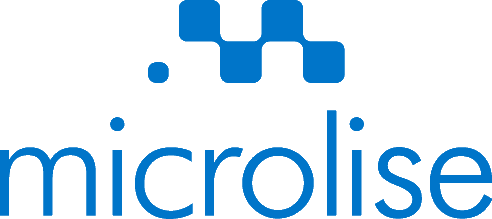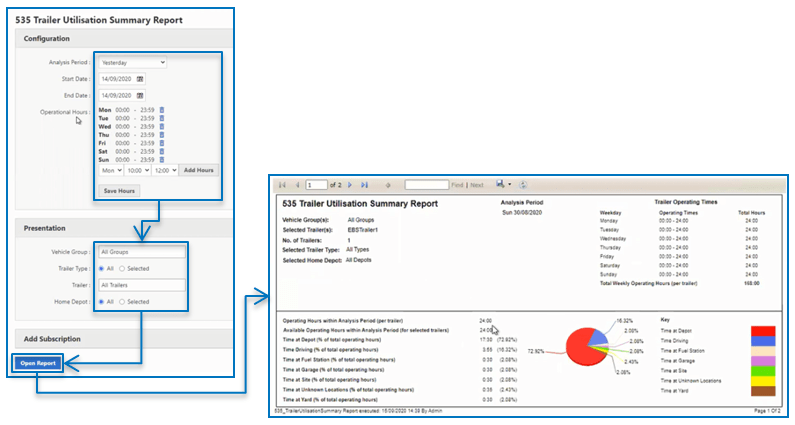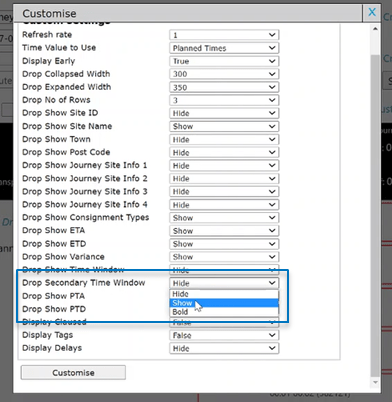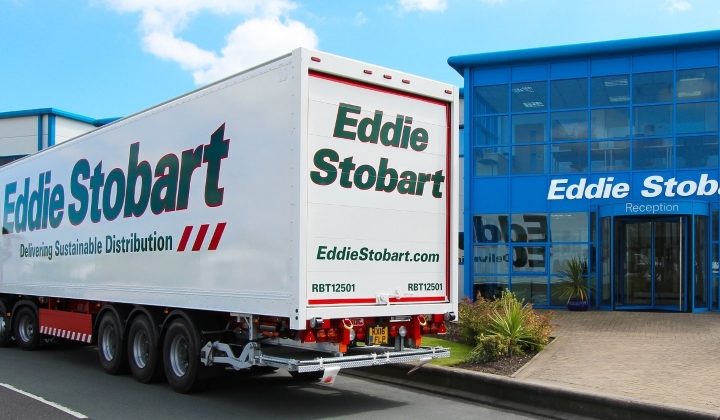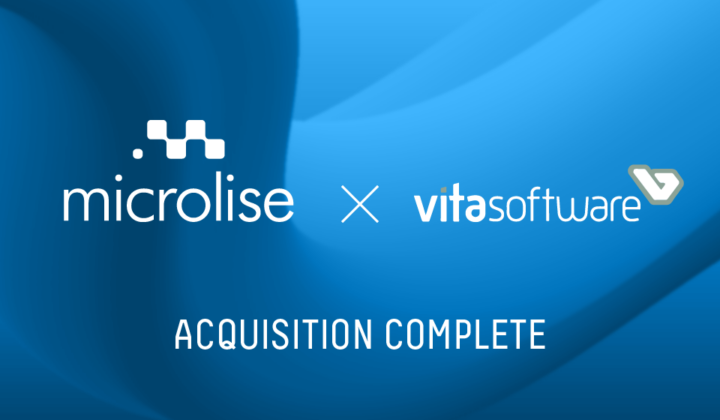As 2020 continues to offer unique challenges, Microlise has continued to develop new features to enhance existing functionality to support our customers. The improved trailer fleet management capability introduced in previous releases has been expanded within the 20.9 release, alongside other incremental improvements that have been made across the full range of our products.
Trailer Telematics
Over the last several months we have made a series of improvements within Fleet Performance to introduce new functionality around the management of vehicle and trailer fleets. With the 20.9 release, two new reports have been added to help our customers gain a deeper level of information about the activities of their trailer fleet. Within a specified date range, the new reports will provide a detailed breakdown of trailer activity, showing both the total duration and how long a trailer has been used for individual activities such as delivering to sites, stopping at depots, and being in transit between locations. The total number of completed journeys made by all trailers in the report within the date range, will also be shown.
It is possible to present this information as a table or a pie chart broken down into percentages, to quickly build an at-a-glance picture of how trailers are being utilised. This allows fleet managers to adapt the activities their trailers are assigned to, in order to better meet their changing circumstances and shifting levels of demand. These reports can be filtered across a range of variables to ensure that the analytics data being shown is most relevant to the user.
Within the Schedule Execution Board (SEB) an advanced search function has also been added, along with a range of filters, showing Web Portal users all available trailers to make the process of assigning a trailer to a new journey easier and quicker.
Clearvision Integrated Multi-Camera Solution
Within another aspect of Fleet Performance, our camera solution has also been enhanced as part of the 20.9 release.
The storage space available on the purchased DVR unit and the number of cameras being used to record footage at any one time can affect how long footage is available to review after an incident has occurred.
When using the Fleet Playback interface to review camera footage, users will see a warning message to notify them if they are trying to access a recording that has been replaced by newer footage to make the most efficient use of available DVR space. Users will also receive a similar error message within Incident Analysis interface. This will add greater clarity to the process, saving our customers time when accessing their camera footage.
Journey Management
Moving on to our Journey Management solution, the Microlise system now supports dual time windows (for instance, when a site has a ‘cut off point’ and does not accept deliveries during lunch hours) when tracking journeys. This can be implemented via adding a secondary time window to a collection or delivery through new customisation options on the SEB.
As a result, adherence to plan-vs-actual times can be tracked before and after the cut-off point in the same way all other journeys are tracked, providing users with a more complete view of their resources so that they can modify their planned journeys to meet their organisation’s needs.
Mobile EPOD Apps
Both the SmartPOD and SmartFlow ePOD mobile apps have also seen new functionality and improvements in the 20.9 release. It should be noted that the latest version of SmartPOD and SmartPOD Plus are now only compatible on Android devices running the KitKat (4.4) operating system and above.
Several enhancements have been made to signature capture functionality within the SmartPOD app. As part of the supervisor release process at loading, the capture of a supervisor’s PIN code and signature can now be required before the process can be completed. This ensures that items must be checked by a supervisor and approved as required before being sent out for delivery. Supervisor signatory information can be audited from the Load Details page within the Web Portal if necessary. When a signature is captured, the SmartPOD application can record a date/time stamp and the location (via latitude/longitude coordinates). Although previously only visible on the Web Portal, this information is now also visible within the PODPOC export.
For customers with drivers who frequently make repeat deliveries to the same sites, it is now possible to view a listed selection (customisable to up to ten signatories) of previous signatories. This list will be sorted by the last used date so that the last person to sign for a delivery will always appear first. This removes the need for drivers to manually enter identical name details every time they visit the same site, speeding up the delivery process.
Within SmartFlow, further improvements have been made with the aim of matching the capabilities between SmartFlow and SmartPOD apps. It is now possible to display all activities a task is comprised of within a scrollable, single-page view, in order to make it easier for the driver to see a complete list of every step required to complete a task, improving driver efficiency.
Planning & Optimisation
Finally, new functionality has also been incorporated into our Planning & Optimisation tool as part of the 20.9 release. To improve the output of the Planning & Optimisation tool for our users and increase the efficiency of optimised plans, factors such as geographical proximity between different deliveries and between delivery and collection locations have been re-examined, and planners can now choose to group multiple deliveries or collections for the same customer when putting together a plan, thereby speeding up the delivery process.
The first phase of our new Load Builder functionality has also been introduced with the 20.9 release. The Load Builder will take order information alongside data on the vehicles and drivers being used to execute the plan being built, as well as any operational limits put in place. This will then be used to produce a simple set of recommendations for how warehouse staff should best load orders onto pallets, and then pallets onto vehicles, so that the staff at the delivery point have the easiest and fastest method of unloading available. A pallet loading sequence is also provided based on the plan and accounting for the vehicle’s pallet footprint and picking process within the warehouse, if this information has been provided.
Two-man deliveries are supported with the Planning & Optimisation tool (referred to as ‘Helpers’) and it can be specified by planners whether a helper is optional, or is required for health and safety or efficiency reasons. This information was previously specified at Order level, and with 20.9 additional criteria has now been introduced. It is now possible to establish a site-level mandate (i.e. Helpers are always required at certain sites), base the Helper calculation on the size of the order in pallets by weight or volume, or set the tool to judge the requirement for a Helper by difficulty (i.e. the total physical stress level expected on the route being undertaken).
Our Next Product Release
In line with each release, we hold a webinar to run through the new features and functionality. If you’re a Microlise customer and are the person within your organisation that receives the release notes, be sure to register for the 20.10 release webinar as below. Alternatively, our account managers are always happy to help with any more immediate questions you may have.
